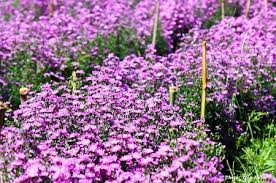Flowers, with their exquisite diversity, have evolved remarkable adaptations to thrive in diverse climatic conditions around the world. From arid deserts to humid rainforests, these plants demonstrate incredible resilience and adaptation. Let’s delve into how flowers have adapted to different climate zones:

1. Desert Adaptations: In desert regions characterized by extreme heat and scarce water, flowers have evolved unique survival strategies. Succulent plants like cacti store water in their fleshy stems, enabling them to endure prolonged droughts. Desert wildflowers such as desert marigold (Baileya multiradiata) and brittlebush (Encelia farinosa) bloom briefly after rare rainfall, quickly germinating and setting seed before conditions become inhospitable again.
2. Tropical Rainforest Species: Tropical rainforests, with their consistent warmth and high humidity, support a dazzling array of flowering plants. Orchids, bromeliads, and heliconias thrive in the dense shade of the forest canopy, using specialized structures to capture light and moisture. Epiphytic orchids and bromeliads grow on trees, absorbing moisture and nutrients from the air.
3. Alpine and Arctic Flowers: At high altitudes and latitudes, flowers face cold temperatures, strong winds, and short growing seasons. Alpine species like alpine gentians (Gentiana spp.) and Arctic poppies (Papaver radicatum) have adapted by growing close to the ground to minimize exposure to harsh conditions. They often have woolly or hairy leaves and stems to insulate against cold and reduce water loss.
4. Temperate Zone Adaptations: In temperate regions, where seasons change dramatically, flowers have evolved strategies to synchronize their life cycles with seasonal cues. Spring-blooming bulbs like tulips and daffodils use winter dormancy to survive freezing temperatures, while summer perennials like daylilies and coneflowers maximize growth during warmer months.
5. Mediterranean Adaptations: Plants in Mediterranean climates, characterized by hot, dry summers and mild, wet winters, exhibit adaptations to conserve water. Mediterranean flowers like lavender (Lavandula spp.) and rosemary (Rosmarinus officinalis) have small, thick leaves that reduce water loss through transpiration. They often produce aromatic compounds that deter herbivores and attract pollinators.
6. Monsoon-Adapted Flowers: In regions with monsoon climates, such as parts of Southeast Asia and India, flowers have adapted to heavy rainfall and humid conditions. Tropical monsoon flowers like plumeria (Frangipani spp.) and hibiscus (Hibiscus rosa-sinensis) thrive during the wet season, benefiting from abundant moisture and warmth.
7. Xerophytic Adaptations: Xerophytic flowers, adapted to arid environments, have specialized structures to minimize water loss. Succulents like agaves and aloes store water in their leaves, while desert-adapted wildflowers have deep taproots to access underground moisture.
Flowers’ ability to thrive in diverse climates underscores their evolutionary versatility and ecological importance. These adaptations not only ensure the survival of plant species but also contribute to the resilience and biodiversity of ecosystems worldwide.
Part 2: Flowers and Adaptation to Varied Climatic Conditions Worldwide
Flowers exhibit an extraordinary ability to adapt to diverse climate conditions across the globe. This adaptation is crucial for their survival and has profound implications for the ecosystems they inhabit. Let’s explore further how different flowers have evolved in response to varied climate zones:
8. Coastal and Mangrove Adaptations: Coastal regions and mangrove ecosystems present unique challenges for plant life due to saltwater exposure and fluctuating tides. Coastal flowers like beach morning glory (Ipomoea pes-caprae) and sea lavender (Limonium spp.) have developed salt-tolerant traits, including specialized glands that excrete excess salt and adaptations to conserve water in saline environments.
9. Steppe and Prairie Flowers: Grasslands and prairies, characterized by hot summers and cold winters, support diverse flowering plants adapted to fire and grazing. Prairie flowers like coneflowers (Echinacea spp.) and prairie clovers (Dalea spp.) have deep root systems that access water deep underground. Some species require periodic fires to stimulate seed germination and control competing vegetation.
10. Subtropical and Semi-Arid Adaptations: Subtropical regions with distinct wet and dry seasons host a range of flowers adapted to seasonal shifts. Plants like bougainvillea (Bougainvillea spp.) and oleander (Nerium oleander) thrive in semi-arid conditions, using efficient water-storage strategies and drought-tolerant traits to survive extended dry periods between rains.
11. Temperate Rainforest Species: Temperate rainforests, found in regions like the Pacific Northwest of North America and parts of New Zealand, boast towering trees and an understory of lush vegetation. Flowers such as trilliums (Trillium spp.) and columbines (Aquilegia spp.) have adapted to low light levels and high humidity, often relying on insects for pollination due to reduced wind movement.
12. Alpine Meadows and Tundra Adaptations: Flowers in alpine and tundra regions face extreme cold, strong winds, and a short growing season. Alpine meadow species like edelweiss (Leontopodium alpinum) and Arctic bell heather (Cassiope tetragona) have compact growth forms and hairy leaves to conserve heat and reduce water loss. Many alpine flowers bloom profusely during the brief summer months to maximize seed production.
13. Floodplain and Riparian Flowers: Plants in floodplain and riparian ecosystems have adapted to periodic flooding and fluctuating water levels. Flowers like water lilies (Nymphaea spp.) and marsh marigolds (Caltha spp.) thrive in wet environments, with adaptations that allow them to float or withstand submerged conditions during flood events.
14. Urban and Cultivated Species: In urban environments, flowers have adapted to human-modified landscapes, including pollution and altered light and moisture levels. Many cultivated flowers like petunias (Petunia spp.) and geraniums (Pelargonium spp.) have been selectively bred for ornamental traits and adaptability to urban gardening conditions.
The diversity of flower adaptations reflects the intricate interplay between plants and their environments. Understanding how flowers adapt to different climates not only enriches our appreciation of botanical diversity but also highlights the importance of conserving natural habitats to safeguard these unique adaptations.